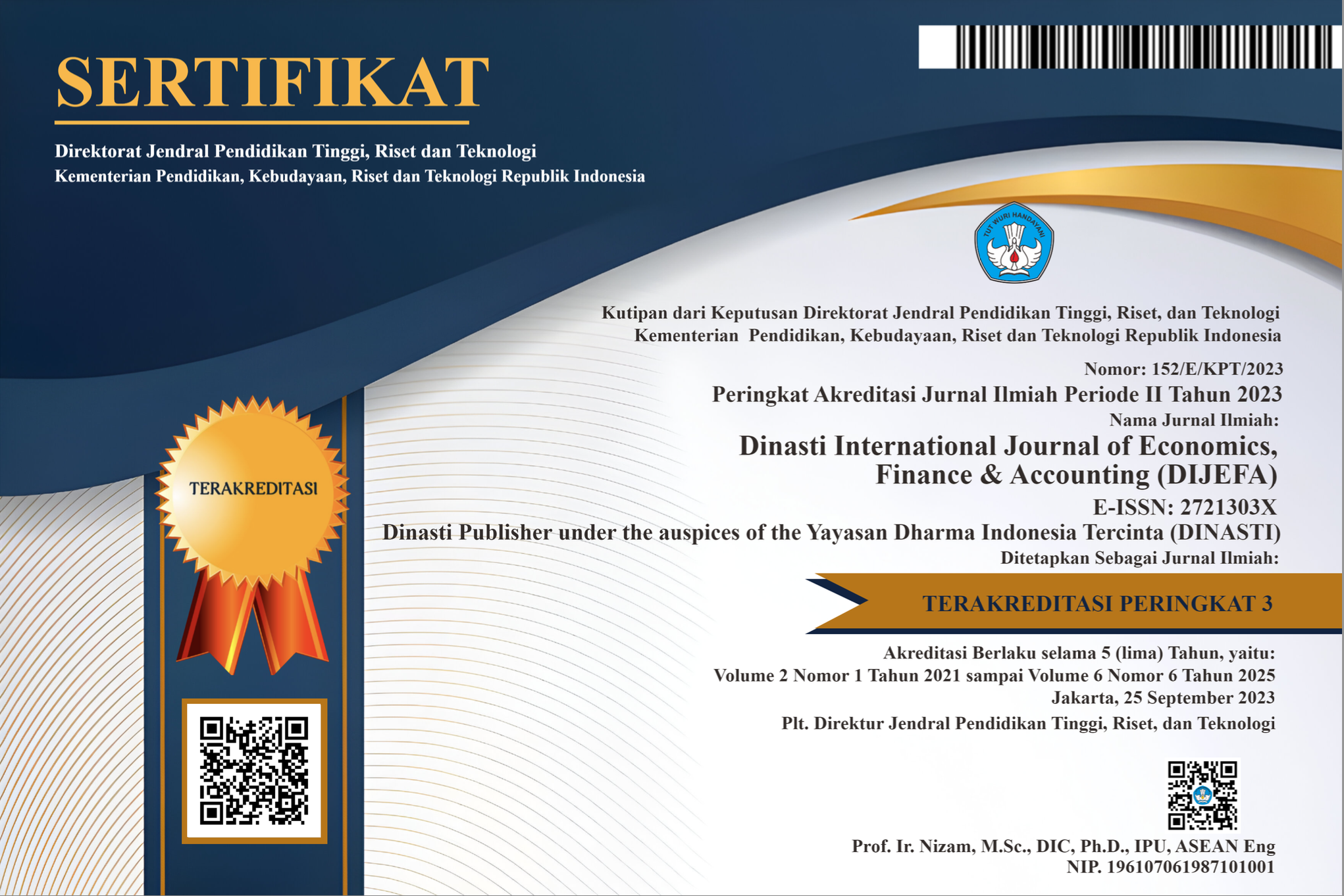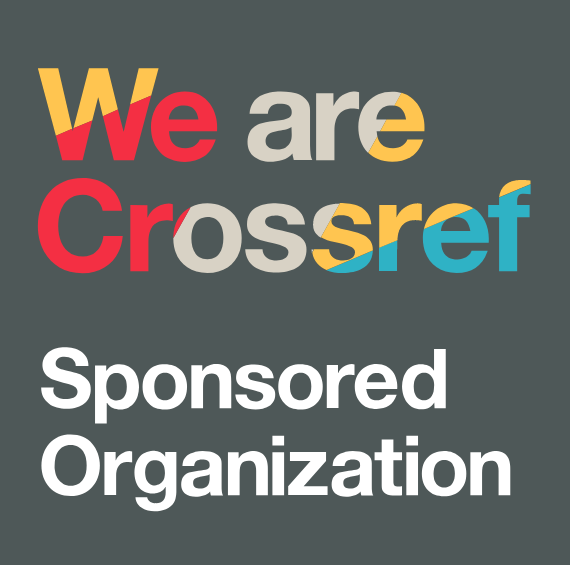Entrepreneurial Orientation Dimensions, Competitive advantage, and Indonesian F&B SMEs Performance
DOI:
https://doi.org/10.38035/dijefa.v5i6.4055Keywords:
Competitive advantage, enterprenurial orientation, food and beverage industry, firm performance, small and medium-sized enterprisesAbstract
This research examines the relationship between entrepreneurial orientation and the performance of SMEs within the food and beverage industry in East Java – Indonesia. With the help of an online survey, data were gathered from 105 participants using a structured questionnaire adopting an exploratory quantitative research design. These highlights indicate that many respondents are mature business people, with over 50% being 36 years and above. The study reveals that F&B remains the fastest-growing sector, with an average annual growth rate of 5.33% after COVID-19. The findings of the study show that the element of entrepreneurial orientation has the most significant impact on the firm competitiveness and performance. This research adds to the literature on how these businesses can effectively manage environmental changes and adjust to new opportunities and threats. The findings indicate that educating SME owners about entrepreneurship would enhance the businesses’ performances and sustainability in the F&B market
References
Abadi, Y. B., Moeljadi, ., Rahayu, M., & Irawanto, D. W. (2022). Proactive and Reactive Innovation Toward Market Performance of Indonesian Furniture. Proceedings of the 3rd International Seminar and Call for Paper (ISCP) UTA ’45 Jakarta, 32–40. https://doi.org/10.5220/0011865100003582
Akossou, A. Y. J., & palm, R. (2013). Impact of Data Structure on the Estimators R-Square and Adjusted R-Square in Linear Regression. International Journal of Mathematics & ComputationTM, 20(3), 84–93. http://www.ceser.in/ceserp/index.php/ijmc/article/view/2579
Aldabbas, H., & Oberholzer, N. (2024). The influence of transformational and learning through R&D capabilities on the competitive advantage of firms. Arab Gulf Journal of Scientific Research, 42(1), 85–102. https://doi.org/10.1108/AGJSR-08-2022-0141
Amaya, N., Bernal-Torres, C. A., Nicolás-Rojas, Y. W., & Pando-Ezcurra, T. T. (2024). Role of internal resources on the competitive advantage building in a knowledge-intensive organisation in an emerging market. VINE Journal of Information and Knowledge Management Systems, 54(5), 1153–1169. https://doi.org/10.1108/VJIKMS-01-2022-0029/FULL/PDF
Badan Pusat Statistik Provinsi Jawa Timur. (2023, June 12). Persentase Penduduk Perempuan Usia 10 Tahun Ke Atas di Jawa Timur dengan Usia Kawin Pertama di bawah 17 Tahun Dirinci Menurut Kabupaten/Kota, 2020-2022. https://jatim.bps.go.id/id/statistics-table/1/Mjg1MSMx/persentase-penduduk-perempuan-usia-10-tahun-ke-atas-di-jawa-timur-dengan-usia-kawin-pertama-di-bawah-17-tahun-dirinci-menurut-kabupaten-kota-2020-2022.html
Barella, Y., Fergina, A., Mustami, M. K., Rahman, U., & Alajaili, H. M. A. (2024). Quantitative Methods in Scientific Research. Jurnal Pendidikan Sosiologi Dan Humaniora, 15(1), 281. https://doi.org/10.26418/j-psh.v15i1.71528
Barney, J. (1991). Firm Resources and Sustained Competitive Advantage. Journal of Management, 17(1), 99–120. https://doi.org/10.1177/014920639101700108
Chen, J. (2017). Towards New and Multiple Perspectives on Innovation. International Journal of Innovation Studies, 1(1), 1–4. https://doi.org/10.3724/SP.J.1440.101001
Christmann, A., & Van Aelst, S. (2006). Robust estimation of Cronbach’s alpha. Journal of Multivariate Analysis, 97(7), 1660–1674. https://doi.org/10.1016/j.jmva.2005.05.012
Cohen, J. (2013). Statistical Power Analysis for the Behavioral Sciences. Routledge. https://doi.org/10.4324/9780203771587
Futri, I. N., Risfandy, T., & Ibrahim, M. H. (2022). Quota sampling method in online household surveys. MethodsX, 9, 101877. https://doi.org/10.1016/j.mex.2022.101877
Gomes, G., Seman, L. O., Berndt, A. C., & Bogoni, N. (2022). The role of entrepreneurial orientation, organizational learning capability and service innovation in organizational performance. Revista de Gestão, 29(1), 39–54. https://doi.org/10.1108/REGE-11-2020-0103
Hair, J. F., Ringle, C. M., & Sarstedt, M. (2013). Partial Least Squares Structural Equation Modeling: Rigorous Applications, Better Results and Higher Acceptance. Long Range Planning, 46(1–2), 1–12. https://doi.org/10.1016/j.lrp.2013.01.001
Hedayat, A., & Seiden, E. (1970). $F$-Square and Orthogonal $F$-Squares Design: A Generalization of Latin Square and Orthogonal Latin Squares Design. The Annals of Mathematical Statistics, 41(6), 2035–2044. https://doi.org/10.1214/aoms/1177696703
Islami, X., Mustafa, N., & Topuzovska Latkovikj, M. (2020). Linking Porter’s generic strategies to firm performance. Future Business Journal 2020 6:1, 6(1), 1–15. https://doi.org/10.1186/S43093-020-0009-1
Jogaratnam, G. (2017). The effect of market orientation, entrepreneurial orientation and human capital on positional advantage: Evidence from the restaurant industry. International Journal of Hospitality Management, 60, 104–113. https://doi.org/10.1016/j.ijhm.2016.10.002
Kimberlin, C. L., & Winterstein, A. G. (2008). Validity and reliability of measurement instruments used in research. American Journal of Health-System Pharmacy, 65(23), 2276–2284. https://doi.org/10.2146/ajhp070364
Liu, Y. (2020). Research on Fiscal Expenditure Structure and High-Quality Economic Development: An Empirical Study Based on Panel Data from Chinese Provinces from 2007 to 2017. American Journal of Industrial and Business Management, 10(02), 232–249. https://doi.org/10.4236/ajibm.2020.102015
Lumpkin, G. T., & Dess, G. G. (1996). Clarifying the Entrepreneurial Orientation Construct and Linking It to Performance. The Academy of Management Review, 21(1), 135. https://doi.org/10.2307/258632
Mostafiz, M. I., Hughes, M., & Sambasivan, M. (2022). Entrepreneurial orientation, competitive advantage and strategic knowledge management capability in Malaysian family firms. Journal of Knowledge Management, 26(2), 423–458. https://doi.org/10.1108/JKM-09-2020-0693/FULL/XML
Norsalehe, N. I., & Idris, A. (2023). Review on entrepreneurial orientation, economic stimulus packages, differentiation strategy and SME performance in Malaysia during the COVID-19 pandemic. Journal of Research in Marketing and Entrepreneurship, 25(2), 286–309. https://doi.org/10.1108/JRME-02-2022-0019
Patrisia, D., Linda, M. R., & Abror, A. (2022). Creation of competitive advantage in improving the business performance of banking companies. Jurnal Siasat Bisnis, 121–137. https://doi.org/10.20885/jsb.vol26.iss2.art1
Piano, N. (2022). Neoliberalism, leadership, and democracy: Schumpeter on “Schumpeterian” theories of entrepreneurship. European Journal of Political Theory, 21(4), 715–737. https://doi.org/10.1177/1474885120960439
Pusung, C. S., Narsa, N. P. D. R. H., & Wardhaningrum, O. A. (2023). Innovation, Competitive Strategy and MSME Performance: A Survey Study On Culinary Smes In Indonesia During The COVID-19 Pandemic. Business: Theory and Practice, 24(1), 160–172. https://doi.org/10.3846/btp.2023.16676
Radomska, J., Wo?czek, P., & Szpulak, A. (2021). Injecting courage into strategy: the perspective of competitive advantage. European Business Review, 33(3), 505–534. https://doi.org/10.1108/EBR-12-2019-0306
Soares, M. do C., & Perin, M. G. (2019). Entrepreneurial orientation and firm performance: an updated meta-analysis. RAUSP Management Journal, 55(2), 143–159. https://doi.org/10.1108/RAUSP-01-2019-0014
Taouab, O., & Issor, Z. (2019). Firm Performance: Definition and Measurement Models. European Scientific Journal ESJ, 15(1). https://doi.org/10.19044/esj.2019.v15n1p93
Totok Irawan, T., Najib Bin Mansor, M., & Alwani Ramlee, A. (2023). Entrepreneurial Orientation and Firm Performance: A Systematic Review. European Business & Management. https://doi.org/10.11648/j.ebm.20230903.12
Vogt, C., van Gils, S., Van Quaquebeke, N., L. Grover, S., & Eckloff, T. (2021). Proactivity at Work. Journal of Personnel Psychology, 20(3), 114–123. https://doi.org/10.1027/1866-5888/a000275
World Economic Forum. (2021, September 30). Indonesia’s SMEs are key to development. How can they grow? https://www.weforum.org/stories/2021/09/how-can-indonesian-smes-scale-up/
Downloads
Published
How to Cite
Issue
Section
License
Copyright (c) 2025 Shrinithy Parthasarathi, Gracia Ongkowijoyo

This work is licensed under a Creative Commons Attribution 4.0 International License.
Authors who publish their manuscripts in this journal agree to the following conditions:
- The copyright on each article belongs to the author(s).
- The author acknowledges that the Dinasti International Journal of Economics, Finance & Accounting (DIJEFA) has the right to be the first to publish with a Creative Commons Attribution 4.0 International license (Attribution 4.0 International (CC BY 4.0).
- Authors can submit articles separately, arrange for the non-exclusive distribution of manuscripts that have been published in this journal into other versions (e.g., sent to the author's institutional repository, publication into books, etc.), by acknowledging that the manuscript has been published for the first time in the Dinasti International Journal of Economics, Finance & Accounting (DIJEFA).


























































